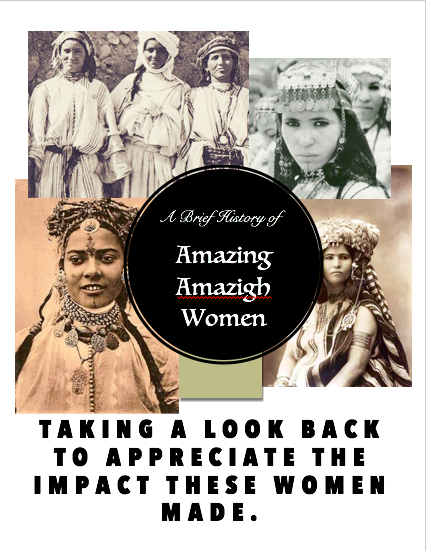
In the past, Amazigh women were once honoredand revered for their strength and leadership. Queens and goddesses among the Amazigh were significant players in politics and society, and these strong figures were necessary for the evolution and survival of the Amazigh people and culture. Although there are more likely to be many more queens and goddesses who have been lost tohistoricalrecord, some of these queens are still known today.
Dihya, or Kahina, was an Amazigh queen and war leader in the late seventeenth century to early eighth century. She succeeds Caecilius as the war leader of the free Berber tribes in the 680’s and ruled a free Berber state from the Aures mountains to the Oasis of Gadames from 695 to 700. During the early years of her reign, Queen Dihya was challenged by Arab encroaching Islamic armies of the Umayyad caliphate, who had been told that the most powerful queen in North Africa was the « queen of the Berbers ». Although the Umayyad army was powerful and had already defeated many other cities such as Carthage, Queen Dihya was triumphant and the Umayyads retreated to Libya and did not return for five years. In a desperate attempt to save her people from the return of the army, Dihya embarked upon a scorched-earth campaign in order to make the territory less attractive to the Umayyad army; however, this campaign ultimately harmed her people more than it prevented further attack. In 702, the army returned and Queen Dihya was defeated and died in battle, although historians have not confirmed the cause of her death. She has spent many years fighting for the freedom and religion of her people. Queen Dihya was a significant figure in the history of the Amazigh She has spent many years fighting for the freedom and religion of her people. Queen Dihya was a significant figure in the history of the Amazigh She has spent many years fighting for the freedom and religion of her people. Queen Dihya was a significant figure in the history of the Amazighcelebrities, and is an example of how Amazigh women have stood for freedom and boldness throughout history.
Tanit was a goddess worshipped by the Amazigh people in the first Berber religion, along with her husband and dual male deity, Ba’al. Tanit is said to have been a Punic and Phoenician deity worshipped across North Africa by the Berber people and in Carthage. Dea Caelestis. The Amazigh has a long history ofHonoring women.
Tin Hinan, historians do not know about Tuareg tribes, possibly in the Hoggar region of modern-day Algeria. She is known asTamenukalt,or the « Mother of All » or « she of the tribes ». In the year 1925 her tomb was opened by Byron Khun of Prorok and the French Army, and in 1933 archaeologists discovered the skeleton of a woman most likely buried in the fourth century, laying on a wooden litter facing east, accompanied by heavy gold, silver , and pearljewelry. thisjewelryThis is a book which is a corroborated by Tuareg legends about the tomb and the woman buried there. Many Arabic sources have been aware of the fact that, as Ibn Khaldun, prominent North African historian, whose story of the woman is most likely to be the most important of the Hoggar named Tiska, most likely related to Tin Hinan.
After the death of her husband, Queen Zenobia took power of the city-state of Palmyra – an essential checkpoint for traders on the Old Silk Road in the last 200 years. three fold. Her rule ended when the Romans finally captured her and made her walk in golden chains in Aurelian’s Triumphal parade. More strong and capable women came next. Zabibi and then immediately after, Samsi were warrior queens in the eighth century and led great armies ofPrimarily women.
Amazigh Women throughout history have been strong and leading members of their people. Amazigh women today have the right to once again boast their history, culture, and right to be proud of their language and customs. Like the past Amazigh queens, Amazigh women todayarefighting for their people and their right to exist freely in their lands.
Works Cited
Amazigh Woman. Digital image. S-media-cache-ak0 . Np, nd Web. 09 Mar. 2017.
Amazigh Woman with Jewelry. Digital image. S-media-cache-ak0 . Np, nd Web. Mar 9, 2017.
« Dihya. » Wikipedia . Wikimedia Foundation, 07 Mar. 2017. Web. 09 Mar. 2017.
« The Monumental Tomb of Queen Tin Hinan, Ancient Ancestress of the Tuaregs. » Ancient Origins . Ancient Origins, 28 Mar. 2015. Web. 09 Mar. 2017.
« MORE WOMEN RULERS. » Women in World History Curriculum . Women in World History Curriculum, nd Web. 09 Mar. 2017.
Sadiqi, Fatima. « Oral Knowledge in Berber Women’s Expressions of the Sacred. » Oral Knowledge in Berber Women’s Expressions of the Sacred (nd): 1-16. Web. 09 Mar. 2017.
Smiling Amazigh Woman. Digital image. S-media-cache-ak0 . Np, nd Web. 09 Mar. 2017.
« Tanith. » Wikipedia . Wikimedia Foundation, 07 Mar. 2017. Web. 09 Mar. 2017.
Three Amazigh Women. Digital image. Tumblr . Np, nd Web. 09 Mar. 2017.

